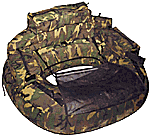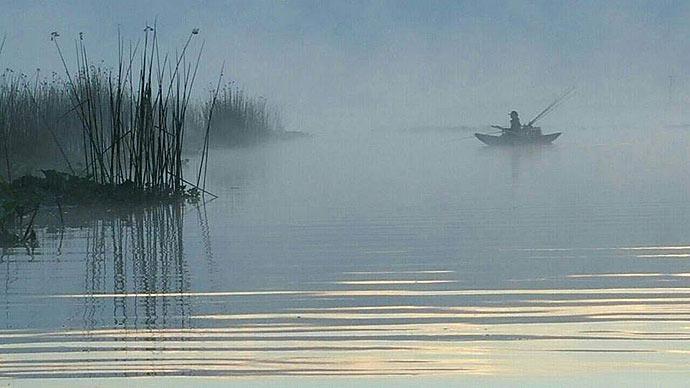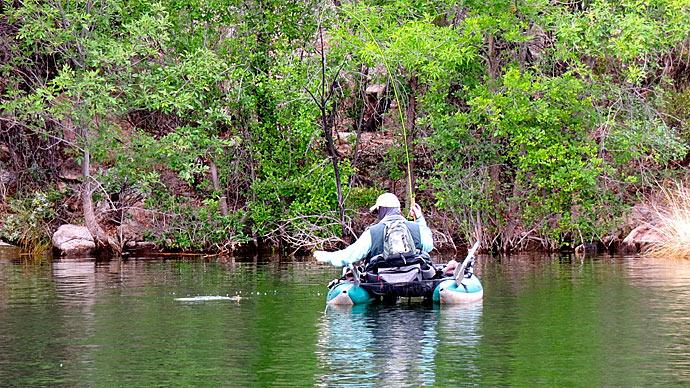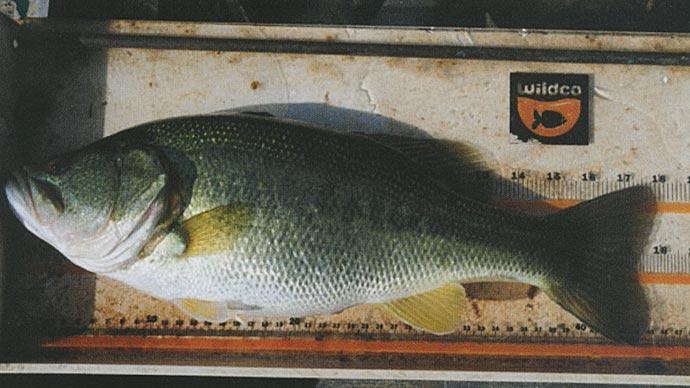
Want to hit those honey holes out in the middle of the lake, but don't have the buck's to spend on a bass rig? Not enough room at your place to keep it? Can't even launch a jon boat into your favorite fishing hole? Well, the solution to your problem might be a float tube. You can get everything you need for less than $150.00, but always remember, you get what you pay for.
I joined the Navy in '82 and I have three years until retirement. I've fished all over the world. Most Captains won't let you keep a bass boat onboard his ship, but a float tube is easy to slip into a sea bag. At the time I didn't know any other float tubers and most of what I learned is by trial and error. Lots of errors. I bought a 19ft Champion with a 175hp Mercury a few years back, and I thought that would be it for my tube. Nope, I use it as much as ever. I like to fish water that doesn't get a lot of pressure. Those are places that boats aren't allowed, or there aren't any ramps. After a long day at work, I find it easier to float tube then to mess with the hassles of my boat. I use my boat on weekends and for tournaments.
I hope this article will help beginners and the more experienced anglers alike. I've tried to cover all aspects of tubing, as well as passing along useful tips and tricks that make my float tubing trips more enjoyable.
There are three styles of float tubes that I will concentrate on in this article. The standard inner tube, the U-Tube, and the pontoon. Each has advantages, and disadvantages. I will briefly cover the pros and cons of each.
Standard tubes
The standard inner tube is the most common, and as a rule, has the lowest price. They start as low as $80.00. I've seen motorized versions go for as much as $700.00. Way too much money! A good tube in the $150.00 price range will give the owner years of service, with just a little preventive maintenance.
The advantages of these types of float tubes are the low costs, and the ease of replacing ruptured tubes. Most inner tubes can be upgraded with a heavy-duty truck tire for only a few dollars. The other types will require writing the manufacturer and paying higher prices.
Their disadvantages is that they are the most difficult to get into, and it will be difficult to reach your feet once you're in the tube. That might not seem like a big deal until your flippers cut off the circulation to your feet, or something of that nature.
The easiest way of getting into a standard float tube is on land. Face the tube away from where you want to enter. Have your fins on and all your equipment in easy reach. The crouch strap should be unbuckled. Place one foot through the opening, and then the next. It can take quite a bit of balancing, especially if you are standing on uneven terrain. Buckle up the crotch strap, and adjust it if necessary. The crotch strap can be buckled up and adjusted while in the water, but it is so much easier to do it on land because you won't have to fight your own weight.
After you are in and adjusted, walk backwards into the lake. This will keep your fins from catching on any objects, and you will be able to walk somewhat normally, although backward. You'll be doing the goose step if you try and walk forward, and it will be very easy to fall.
U-tubes
U-types have an opening in the front, and tend to be more expensive then the standard, although there can be some overlap in the price range. Their main advantage is that they are easy to enter. This would be the tube to get if you are not too coordinated, or have mobility problems. You have easy access to your feet, and can wait till you are in the water to put on your fins. Their disadvantage is that they are less stable in the water, most use aluminum support bars that can eventually be lost, and they require specially designed bladders.
Pontoons
The pontoon type is by far the most expensive, starting in the neighborhood of $250.00. They offer many advantages over the standard and U-type floats. They have great accessibility and are the most stable of the three on the water. With the addition of oars they are by far the fastest. They can also carry more weight, and they also have more room for storage.
The disadvantage of the pontoon type is that they can be the hardest to maneuver, and they are more expensive. Some are inflatable, while others use Styrofoam inserts or composite materials. Regardless, they will weigh more than the others and take up more space. That would be something to consider if you are planning to hike into remote areas.
Equipment and Accessories

Fins
Fins will be the second most important purchase you can make. I recommend the slip on type that can be purchased at Wal-Mart or other retail stores. They are inexpensive, about $20.00 to $35.00, and they will last a long time. Fins will come in many different shapes and sizes. I prefer the longer, narrower, vented styles. They will not bump one another while kicking like the wider flippers will, and the long length displaces a lot of water. The vent slots decrease the drag on the up stroke of the kick, saving you a lot of energy. If you use stocking foot waders, remember to buy the fins in the next larger size. The fins should be snug, but not enough to cut off the blood circulation to your foot.
They make fins that fit over wader boots, but I'm not too impressed with these. They come loose too often, and if the angler isn't careful he can accidentally kick one off. Most sink in water, making it very unlikely that you will be able to find them again. They tend to weigh more than the slip-on fins, and the boots add additional weight to your feet. If all you want is exercise, booted waders and fins are the way to go. The only reason I would buy a set of boot fins is if I already had a pair of booted waders and did not have the money to invest in stocking foot waders.

Waders
I definitely recommend the use of waders, even in the hotter climates. Although not absolutely necessary, waders will protect you from hypothermia, will protect your legs from abrasions, and will keep little critters like leeches from having a free lunch at your expense. Waders won't protect you from Water Moccasins or Crocodiles, so you Southern Boys be careful. Neoprene waders are the most durable, and come in different thicknesses measured in Millimeters.
Some are insulated with other materials to help them retain body heat. In warmer areas a 3.5mm wader will be sufficient. In colder areas extra insulation will be required. Stocking foot chest waders are best, and sell for as low as $60.00. If you have a thin pair of Neoprene waders and want to fish in colder waters, slip in some pocket warmer packs. Put some around your feet because it will be the first part of the body to cool down. Test one of your pocket warmers first, because some brands get hotter than others, and some take a while to get hot. There is nothing worse then to have one of these suckers burning your flesh out in the middle of the lake.
Underlining clothes can also be used to increase your warmth. If you are in warmer climates, a pair of briefs or a tight fitting pair of swim shorts is all you need. In colder climates use soft fabric sweat pants and shirt. Try to keep underlining clothes tight and free of wrinkles. Wrinkled undergarments will get uncomfortable from pinching and rubbing. It can even lead to chaffing of the skin. Ouch.

Boots
Even if you are a few yards away from the water, it pays to put on some footwear. It only takes one sharp rock to puncture a hole in the bottom of your waders, and holes can be difficult to repair. I recommend felt bottom wading boots because of their resistance to rotting, and they can be used if you want to fish without the tube for some reason. The felt soles give excellent footing on slick rocky surfaces. They start at $60.00. Of course a cheap pair of tennis shoes can substitute if all you want to do is protect the waders while getting to the lake.

Anchor Weights
It's a good idea to invest in a pair of 1- to 2-pound fishing weights. The hardest part of float tubing is staying in position. Any amount of wind or current will blow you out of position. If you only use one anchor weight, you will still have a problem holding to a spot because any change of wind direction will push you in a circle around your anchor point. Two work best. Parachute cord or nylon lines are both good choices for securing your anchors.
I don't like using more than 35 feet of line for each. If you need to fish very deep water, you will need to add more line. The more line that you let out the better it's holding power will be.
Find a point you want to anchor at and drop the weight. Drift or paddle into the spot you like and toss the other weight away from you. If you think this will spook the fish, hold your arm out as far as you can and just let the weight sink to the bottom. Tie up the slack line to one of the attachments on your tube. If you still have trouble drifting around you will have to let more line out on your second line. To do this you need to let out more line from the first weight, paddle over to the second anchor point, paddle back to where you want to fish, and take up slack line.
The shape of the weights can make a difference too. Long flat weights will hold the bottom the best, but are easier to get wedged in rocks and weeds. Round-shaped cannon ball types don't snag often, but don't hold as well. If you do manage to snag a weight to the bottom, you can usually free it by getting straight above it, or a little to the side. I have never had to cut a weight off because of a snag. On nice days you won't need anchor weights at all, but from my experience those days will be few and far between.
Be careful of where your anchor lines are while landing a fish. They will wrap you up in it if you let them.

Safety
Life jackets are number one on my safety list. I didn't wear a life jacket when I first started but when my tube started to deflate I wish I had one. Lucky for me, it was a slow leak and I had plenty of time to get to the beach. As my chest waders started to fill with water, I realized that life jackets aren't such a bad idea. It's just too hard to swim with waders and boots and a collapsed float tube around your waist. Most of us are going to hang on to our rods and that will just make things worse. If your tube goes down and you are wearing a life jacket you won't have any problems keeping your gear, and your life.
The second time my tube deflated, I was ready. I was fishing and just having a good time and then I heard that terrible hissing. I checked my tube and saw an incredible leak. I had bumped into a floating palm thrown! Where the heck did that come from? It was water logged about ½" below the surface. I never even saw it. My tube was totally deflated by the time I got the shore. I'm happy I had my life jacket on. If you think you can use the backrest as a floatation device, think again. It's just not designed for that.
Sun block, don't forget it. It's easy to get sunburned in a float tube because you are so close to the water. All of the sun's rays reflect off the water and up on you. I think the smell of sun block causes a negative reaction on bass. I avoid this by using latex gloves to apply the sun block to my skin. It seems to work fine.
Stay clear of boat lanes. You might have the right of way, but it's not going to do you much good if you get keel hulled by a 20 foot Ranger.
I don't recommend drinking alcohol while float tubing. Enough said on that one.
Never put lures or hooks inside your storage compartment. It doesn't take much to puncture and deflate a tube. Find a nice utility box to put all your loose gear into. You will probably lose a little storage space, but sinking a tube is a lot worse. Some float tubes offer extra storage on top of the backrest. Don't use this space for items that you use often. It will be too hard to access when you need it.

Other Tips
It's to your advantage to know where the bass should be, and what they will be biting. It's hard to cover large amounts of water in a float tube. Careful planning is important. Take lures that you have confidence in. You won't have room for a lot of tackle. This makes float tube anglers some of the best bassers there are. They know they can only cover a small area, so they pick the best spots they can. They don't carry a lot of tackle, so they have to master the ones they have.
Wear polarized sunglasses to reduce the glare of the sun, and to see into the water. Amber lenses are best to see into the water. Smoke colors are easier on the eyes.
Most beginners under inflate their tubes. A float tube bladder should be inflated enough to remove most of the wrinkles in the canvas cover. If inflated properly, the tube should be very firm, with just a little give. Properly inflated tubes will keep you higher out of the water, there will be less drag on the float, and it will be faster and easier to paddle around in. Some tubes come with an oral inflating tube. Forget that! It will take forever, and you will never to be able to fill it to the proper PSI. Best bet is to fill it at a local gas station. If that's not possible, buy a small compressor that will work off a cars' 12V cigarette lighter. If you can't even do that, buy the very, very best bicycle pump you can. It can take up to an hour to fill a large tube, so try and get an early start. Might want to stock up on the Ben-Gay too!
Buy an inner tube repair kit from the bicycle section of your favorite store, and have it handy. These little kits work very well, and might just save your day on the water. While you're at the store, buy a valve stem removal tool. These are going to save you tons of time removing air out of the inner tube. It takes forever to drain a tube with the valve stem in it. Remove the stem and it will take less then 5 minutes. Buy extra valve stems too. They will get lost, or wear out. Make sure you get the right length for your tube. Always have extra valve stem caps on hand. Don't go out into the water without one on. It will keep water from entering and corroding your stem. It also prevents air from escaping if your valve stem goes bad. If you forgot it at home, take one off your car.
Never stow your gear wet, or even damp. When you retrieve it for your next fishing trip, you will find your tube, and waders covered with mold, or worse yet, it will have begun to rot.
You can walk faster then you can get there in a float tube. Get as close as possible to the area you want to fish, and launch from there.
Good luck!
Float tubing is a great way to go fishing. It doesn't cost a lot, and it will give you access to areas that can't be reached by shore anglers or boat fishermen. You can get very close to the bass in most cases without spooking the fish. Really, I've done some of my best bass fishing using a float tube. If you haven't tried tubes before, give it a shot, and I'm sure you will agree.




